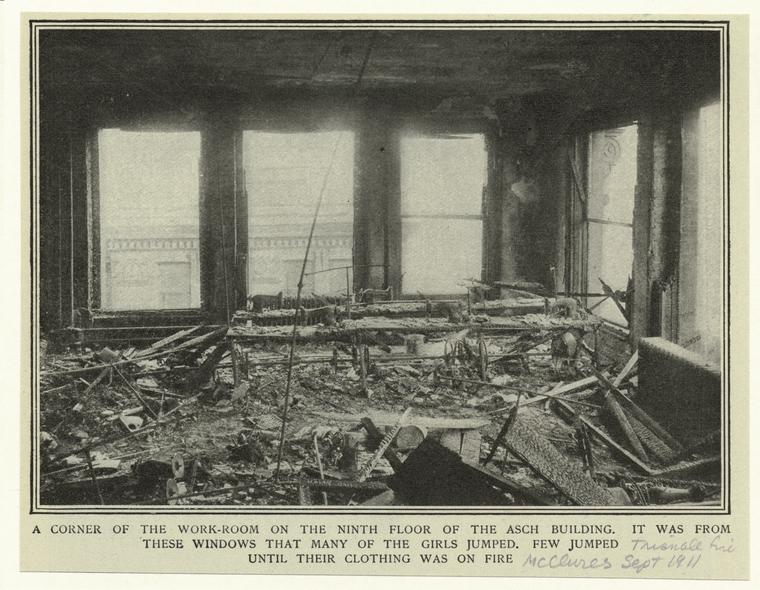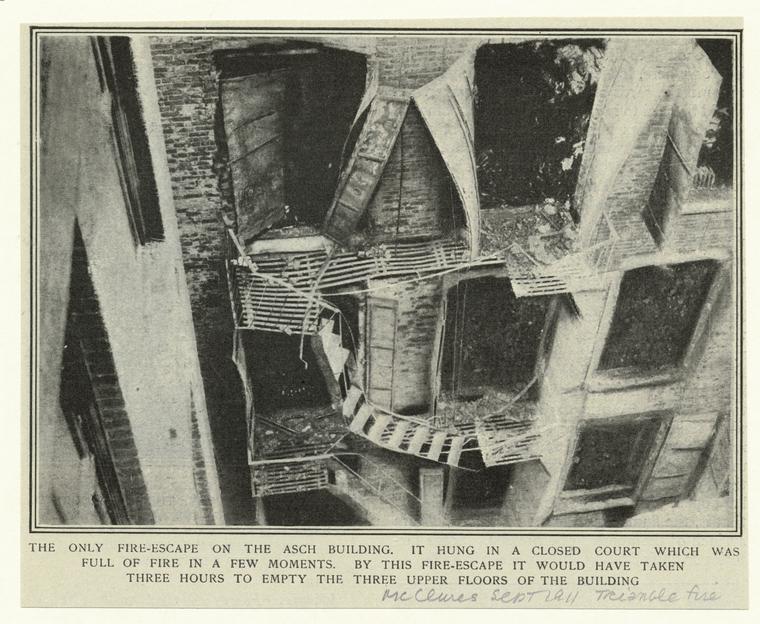How Much Money Did The Triangle Shirtwaist Factory Workers Make
The Factory
In 1911, the Triangle Shirtwaist Factory was the largest shirtwaist manufacturer in New York City, and possibly in the state. The factory thrived on the cheap labor of immigrants flocking to New York Metropolis from Europe. In many cases these immigrants fled oppressive nations, carrying with them their tailoring skills which they passed downward to the younger generations of their families. These immigrants were exploited and forced to piece of work long hours with lilliputian pay in the material factories in New York Metropolis. According to one survey taken in the 1890'south the boilerplate workweek in textile shops was eighty-four hours, twelve hours for every day of the calendar week.
 Entrepreneurs Max Blanck and Issac Harris who also happened to exist in-laws, watched every bit the booming textile manufacture made its mark on New York City. They knew that in that location was money to be made so they embarked upon a program to open the Triangle Shirtwaist Manufactory. The shirtwaist or ladies blouse was one of America's start way trends to transcend the class split. "The waist-and-skirt combination both symbolized and enabled a wave of women's liberation." The shirtwaist was appropriate for working in a factory or attention temperance or ladies auxiliary coming together, a versatility which was a hot commodity in a time when women's vesture was layered and bulky.
Entrepreneurs Max Blanck and Issac Harris who also happened to exist in-laws, watched every bit the booming textile manufacture made its mark on New York City. They knew that in that location was money to be made so they embarked upon a program to open the Triangle Shirtwaist Manufactory. The shirtwaist or ladies blouse was one of America's start way trends to transcend the class split. "The waist-and-skirt combination both symbolized and enabled a wave of women's liberation." The shirtwaist was appropriate for working in a factory or attention temperance or ladies auxiliary coming together, a versatility which was a hot commodity in a time when women's vesture was layered and bulky.
In 1900 Blanck and Harris named their business the Triangle Shirtwaist Factory, moving into an ideal location simply a twelvemonth later, a building named for the developer Joseph Asch. The owners leased the ninth floor of the building which was a little more nine thousand foursquare feet. They outfitted the space with machines and prepare to manufacturing their products. Past 1909, the business leased the eighth and tenth floors of the Ashe building, employing hundreds of workers. Every bit the factory expanded, Blanck and Harris felt vulnerable to union organizers who felt that the workers were treated poorly. The owners felt that the all-time defence force confronting matrimony infiltration was to lock the workers in. This proved to be a devastating decision when the fire bankrupt out in 1911.
The Burn down
Equally eyewitness to the horrific ordeal William G. Shepherd, explained "I learned a new audio–a more horrible sound than description can picture. It was the thud of a speeding, living body on a stone sidewalk. Thud—expressionless, thud—expressionless, thud—dead, thud—dead. Sixty-ii thud—deads. I telephone call them that, considering the sound and the thought of death came to me each time, at the same instant. There was plenty of gamble to watch them as they came downwards. The height was eighty anxiety."
This tragedy is noted equally the worst mill fire in the history of New York Urban center. It occurred on March 25th, 1911 in the Asch building located at the northwest corner of Washington and Greene streets, where the Triangle Shirtwaist Visitor occupied the elevation three of ten floors. The company employed v hundred, mostly Italian and Jewish immigrants between the ages of thirteen and xx-three. In an endeavor to keep the workers at their sewing machines and to go along out matrimony organizers, the proprietors had locked the doors leading to the exits.
 The burn down began shortly afterwards 4:thirty p.m. in the cutting room on the eighth floor, and fed by thousands of pounds of fabric, it spread speedily. Panicked workers rushed to the stairs, the freight elevator, and the fire escape in an effort to evacuate. About on the 8th and tenth floors escaped, withal, dozens trapped on the ninth floor died, unable to force open up the locked door that would have led to their escape. The rear burn escape had collapsed killing many and eliminating an escape route for others still trapped. Some tried to slide down lift cables but lost their grip while others jumped to their death from open windows. Pump Engine Company 20 and Ladder Company 20 arrived quickly but were hindered by the bodies of victims who had jumped. Witnesses thought the owners were tossing their best cloth out the windows to salve it, then realized workers were jumping, sometimes after sharing a kiss. The ladders of Company 20 extended only to the sixth floor, and life nets bankrupt when workers jumped in groups of three and four. Additional companies were summoned by four more alarms transmitted in rapid succession. "Onlookers by the hundreds hurried toward the activeness the fastest amidst them in time to meet tangles of bodies some abaft flames, tumbling from the ninth-floor windows of the Triangle Shirtwaist Company."
The burn down began shortly afterwards 4:thirty p.m. in the cutting room on the eighth floor, and fed by thousands of pounds of fabric, it spread speedily. Panicked workers rushed to the stairs, the freight elevator, and the fire escape in an effort to evacuate. About on the 8th and tenth floors escaped, withal, dozens trapped on the ninth floor died, unable to force open up the locked door that would have led to their escape. The rear burn escape had collapsed killing many and eliminating an escape route for others still trapped. Some tried to slide down lift cables but lost their grip while others jumped to their death from open windows. Pump Engine Company 20 and Ladder Company 20 arrived quickly but were hindered by the bodies of victims who had jumped. Witnesses thought the owners were tossing their best cloth out the windows to salve it, then realized workers were jumping, sometimes after sharing a kiss. The ladders of Company 20 extended only to the sixth floor, and life nets bankrupt when workers jumped in groups of three and four. Additional companies were summoned by four more alarms transmitted in rapid succession. "Onlookers by the hundreds hurried toward the activeness the fastest amidst them in time to meet tangles of bodies some abaft flames, tumbling from the ninth-floor windows of the Triangle Shirtwaist Company."
A total of 146 workers died in less than fifteen minutes. Although there was widespread revulsion and rage over the working conditions that had contributed to the fire, many defended the correct of shop owners to resist regime safety regulation, and some in government insisted that they were at whatever rate powerless to impose information technology. 1The owners of the visitor were charged with manslaughter and later acquitted. In 1914, the owners were ordered to pay damages in the corporeality of $75 to each of the families of 20-iii victims who had sued. The Factory Investigating Committee of 1911 gathered testimony, and later that year the city established the Bureau of Fire Investigation under the direction of Robert F. Wagner, which gave the fire department additional powers to improve factory prophylactic. The consequence crystallized back up for efforts to organize workers in the garment district and in particular for the International Ladies' Garment Workers' Union. It remains i of the most vivid symbols for the American labor motility and a constant reminder that regime must ensure a safety workplace.
Source: https://trianglememorial.org/triangle-history/
Posted by: samonscancest.blogspot.com

0 Response to "How Much Money Did The Triangle Shirtwaist Factory Workers Make"
Post a Comment